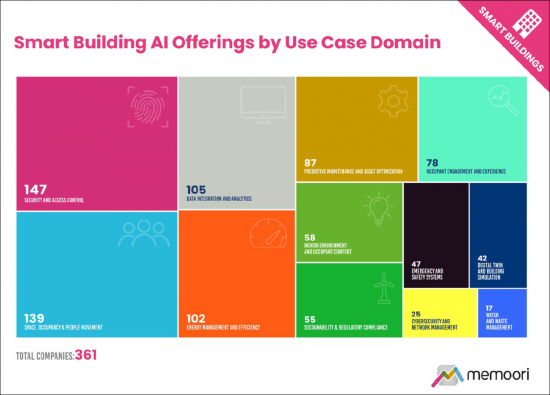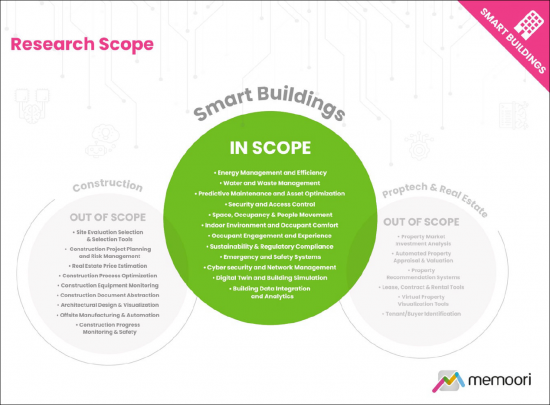 |
市場調查報告書
商品編碼
1462330
商業建築人工智慧(AI)競爭格局(2024)The Competitive Landscape for AI in Commercial Buildings 2024 |
||||||
本報告是截至 2024 年商業建築供應商人工智慧解決方案市場的最新映射和分析。
這項新研究以Memoori 的2021 年人工智慧(AI) 市場分析為基礎,旨在探索AI 的整體能力和專業知識,以實現更智慧、更永續、反應更靈敏的建築環境。
詳細分析描繪了智慧建築公司人工智慧的國際格局,並提供了市場結構的清晰圖像。讀者可以評估各種人工智慧應用的成熟度和潛力,並識別業界領先的供應商。
該報告包含一個電子錶格,將 361 家領先公司(比 2021 年的 255 家增加了 42%)分類為 66 個人工智慧用例,無需額外費用。連同其姐妹報告,這是迄今為止發佈的關於人工智慧對商業建築影響的最完整的評估。
本報告是兩部分報告中的第二部分。 第 1 部分解釋了人工智慧技術、商業機會和用例。 這兩份報告均包含在我們的2024 年高級訂閱服務中,您可以使用大規模語言模型(LLM) 查詢我們的所有研究。 AIM。

主要問題
- 誰是塑造商業建築人工智慧未來的關鍵公司? 這份報告詳細分析了 361 家在人工智慧領域運作的公司,依照用例、公司成立時間和公司規模進行分類。該報告隨附的電子錶格將公司分為 66 個不同的用例,其中人工智慧正在智慧建築市場中積極開發,以供進一步分析。
- 各大公司的AI策略是什麼?本報告審視了 17 家領先公司的策略定位,這些公司在多個人工智慧用例中提供產品和服務。特別是大型樓宇自動化公司(例如Carrier、Honeywell)和大型科技公司(例如Amazon、Microsoft ) ,調查半導體公司(GARM、NVIDIA等)的策略、定位和最新創新。
- 商業建築人工智慧的投資現況如何? 本報告審查了每個國家披露的平均資金總額以及獲得資金的私人公司數量。

這份報告由179頁文字和37張圖表組成,提取了所有重要事實並得出結論,讓您可以瞭解AI技術如何應用於商業建築,也可以準確瞭解原因;
- 本報告重點在於與商業建築目前營運直接相關的用例,例如建築性能、永續性和住戶體驗。另一方面,它沒有涵蓋人工智慧在設計和施工階段的使用。
- 縱觀所有用例的所有 12 個主要領域(總共 66 個),安全性和存取控制成為最受歡迎的領域 (40.7%)。其次是空間、空缺和人員流動(38.5%)、數據整合和分析(29.1%)以及能源管理和效率(28.3%)。
- 美國在私人投資的人工智慧公司數量上遙遙領先,有 88 家公司,但每家公司披露的平均融資金額為 2 億日元,最昂貴,為 8700 萬美元。
本報告提供了寶貴的信息,可幫助公司改善策略規劃並考慮部署人工智慧技術來發展業務的潛力。
目錄
前言
調查範圍與方法
執行摘要
第一章市場現況及趨勢
- 全球智慧建築人工智慧公司狀況
- 智慧建築人工智慧市場:依用例
- 智慧建築人工智慧市場:依公司年齡劃分
- 智慧建築人工智慧市場:依公司規模劃分
第 2 章依用例劃分的競爭格局
- 能源管理/效率
- 供水和污水管理
- 人工智慧硬體運算
- 安全/存取控制
- 空間/空缺/人員流動
- 室內環境/使用者舒適度
- 居民參與度與體驗
- 永續性和監管合規性
- 緊急/安全系統
- 網路安全/網路管理
- 數位孿生/建築模擬
- 資料整合/分析
第三章主要企業策略定位
- 樓宇自動化公司
- ABB
- Carrier
- Honeywell
- Johnson Controls
- Schneider Electric
- Siemens
- Major Tech Firms
- Amazon
- Cisco
- IBM
- Microsoft
- Samsung
- 主要半導體公司
- AMD
- ARM
- Intel
- NVIDIA
- Qualcomm
第四章併購與投資
- 企業併購 (M&A)
- 投資趨勢
- 依地區劃分的投資趨勢
- 著名投資交易
This Report is a New 2024 Mapping and Analysis of Vendor AI Solutions for the Commercial Buildings Market
This new research builds on Memoori's previous 2021 Artificial Intelligence (AI) market analysis, exploring the immense progress that has occurred both in the capabilities of AI and the growing vendor landscape enabling smarter, more sustainable, and more responsive commercial buildings.
The in-depth analysis maps out the global landscape of smart building AI companies, providing a clear picture of the market's structure, and allows the reader to assess the maturity and potential of various AI applications and identify vendors shaping the industry.
It includes, at no extra cost, a spreadsheet that assigns all 361 companies identified (a 42% increase from the 255 companies we identified in 2021) to 66 distinct individual AI use cases. Together with its sister report it is by far the most complete assessment of the impact of AI on commercial buildings published to date.
It is the second in a 2-part series of reports, with the first report providing a review of AI technologies, opportunities and use cases. Both these reports are included in our 2024 Premium Subscription Service, which also gives access to our chatbot AIM, where you can query all our research using the power of Large Language Models (LLMs) .

KEY QUESTIONS ADDRESSED:
- Who are the key players shaping the future of AI commercial building applications? The report provides a granular analysis of 361 companies that we identified as operating in the AI space, segmenting companies by use case, company age, and company size. The spreadsheet that comes with the report provides further in-depth analysis assigning companies to each of the 66 distinct individual use cases where AI is being actively developed for use in the smart buildings market.
- What are the AI strategies of the major players? The report examines the strategic positioning of 17 major players whose offerings typically span multiple use cases for AI. It explores the strategies, positioning and recent innovations of leading building automation firms (e.g. Carrier, Honeywell), big tech (e.g. Amazon, Microsoft), and semiconductor companies (e.g ARM, NVIDIA).
- What does the investment landscape for AI in commercial buildings look like? The report looks at the average total disclosed funding and the number of funded private companies across various countries.

WITHIN ITS 179 PAGES AND 37 CHARTS AND TABLES, THE REPORT FILTERS OUT ALL THE KEY FACTS AND DRAWS CONCLUSIONS, SO YOU CAN UNDERSTAND EXACTLY HOW AI TECHNOLOGY WILL BE APPLIED TO COMMERCIAL BUILDINGS AND WHY;
- The report is focused on the use cases that relate directly to the ongoing operations of commercial buildings, such as building performance, sustainability, and the occupant experience. The scope does not include AI applications for design and construction phases.
- Across 12 distinct use case domains, encompassing a total of 66 individual use cases, Security and Access Control emerges as the most popular domain (40.7%), followed by Space, Occupancy & People Movement (38.5%), Data Integration and Analytics (29.1%), and Energy Management and Efficiency (28.3%).
- In terms of the number of private AI companies being funded, the US is the clear leader with 88, BUT China has the highest average disclosed funding per company at $287 million.
This report provides valuable information to companies so they can improve their strategic planning exercises AND look at the potential for developing their business through implementing AI technology.
WHO SHOULD BUY THIS REPORT?
The information contained in this report will be of value to all those engaged in managing, operating, and investing in commercial buildings (and their advisers) around the world. In particular, those wishing to understand the global landscape of AI & Machine Learning companies in commercial real estate will find it particularly useful.Table of Contents
Preface
Research Scope & Methodology
Executive Summary
1. Market Landscape and Dynamics
- 1.1. The Global Landscape of Smart Building AI Companies
- 1.2. Smart Building AI Market by Use Case
- 1.3. Smart Building AI Market by Company Age
- 1.4. Smart Building AI Market by Company Size
2. Competitive Landscape by Use Case
- 2.1. Energy Management and Efficiency
- 2.2. Water and Waste Management
- 2.3. AI Hardware and Compute
- 2.4. Security and Access Control
- 2.5. Space, Occupancy, and People Movement
- 2.6. Indoor Environment and Occupant Comfort
- 2.7. Occupant Engagement and Experience
- 2.8. Sustainability and Regulatory Compliance
- 2.9. Emergency and Safety Systems
- 2.10. Cybersecurity and Network Management
- 2.11. Digital Twin and Building Simulation
- 2.12. Data Integration and Analytics
3. The Strategic Positioning of Key Players
- 3.1. Building Automation Firms
- ABB
- Carrier
- Honeywell
- Johnson Controls
- Schneider Electric
- Siemens
- 3.2 Major Tech Firms
- Amazon
- Cisco
- IBM
- Microsoft
- Samsung
- 3.3. Major Semiconductor Firms
- AMD
- ARM
- Intel
- NVIDIA
- Qualcomm
4. M&A & Investment
- 4.1. Mergers and Acquisitions
- 4.2. Investment Trends
- Geographic Investment Trends
- Notable Investment Deals
List of Charts and Figures
- Fig 1.0 - Research Scope
- Fig 1.1 - Regional Distribution of Smart Building AI Companies
- Fig 1.2 - AI & Machine Learning Use Cases in Smart Commercial Buildings
- Fig 1.3 - Smart Building AI Offerings by Use Case Domain
- Fig 1.4 - Most Commonly Served Individual Use Cases
- Fig 1.5 - Number of Use Cases Served by Company
- Fig 1.6 - Distribution of Smart Building AI Companies by Age
- Fig 1.7 - Median Company Age by Use Case Domain
- Fig 1.8 - Distribution of Smart Building AI Companies by Size
- Fig 1.9 - Average Company Size by Use Case Domain
- Fig 1.10 - Average Increase in Headcount
- Fig 2.1 - Notable Smart Building AI Companies
- Fig 2.2 - AI for Energy Management & Efficiency in Commercial Buildings
- Fig 2.3 - AI for Water and Waste Management in Commercial Buildings
- Fig 2.4 - AI for Predictive Maintenance and Asset Optimization in Commercial Buildings
- Fig 2.5 - AI for Security and Access Control in Commercial Buildings
- Fig 2.6 - AI for Space, Occupancy & People Movement in Commercial Buildings
- Fig 2.7 - AI for Indoor Environment and Occupant Comfort in Commercial Buildings
- Fig 2.8 - AI for Occupant Engagement and Experience in Commercial Buildings
- Fig 2.9 - AI for Sustainability & Regulatory Compliance in Commercial Buildings
- Fig 2.10 - AI for Emergency and Safety Systems in Commercial Buildings
- Fig 2.11 - AI for Cybersecurity and Network Management in Commercial Buildings
- Fig 2.12 - AI for Digital Twin and Building Simulation in Commercial Buildings
- Fig 2.13 - AI for Data Integration and Analytics in Commercial Buildings
- Fig 4.1 - Global Investment Landscape in AI for Commercial Buildings









